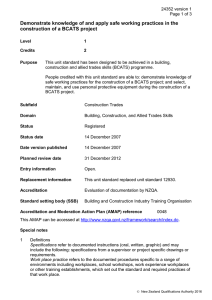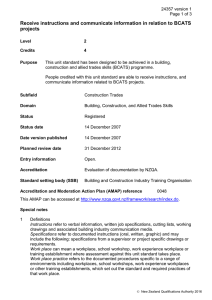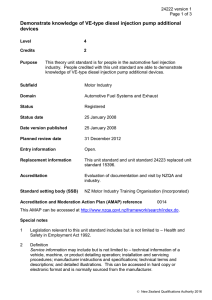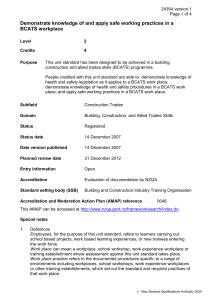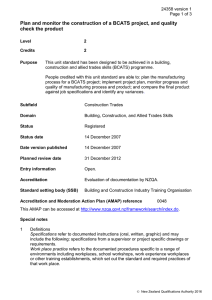Identify, select, maintain, and use hand tools for BCATS projects
advertisement
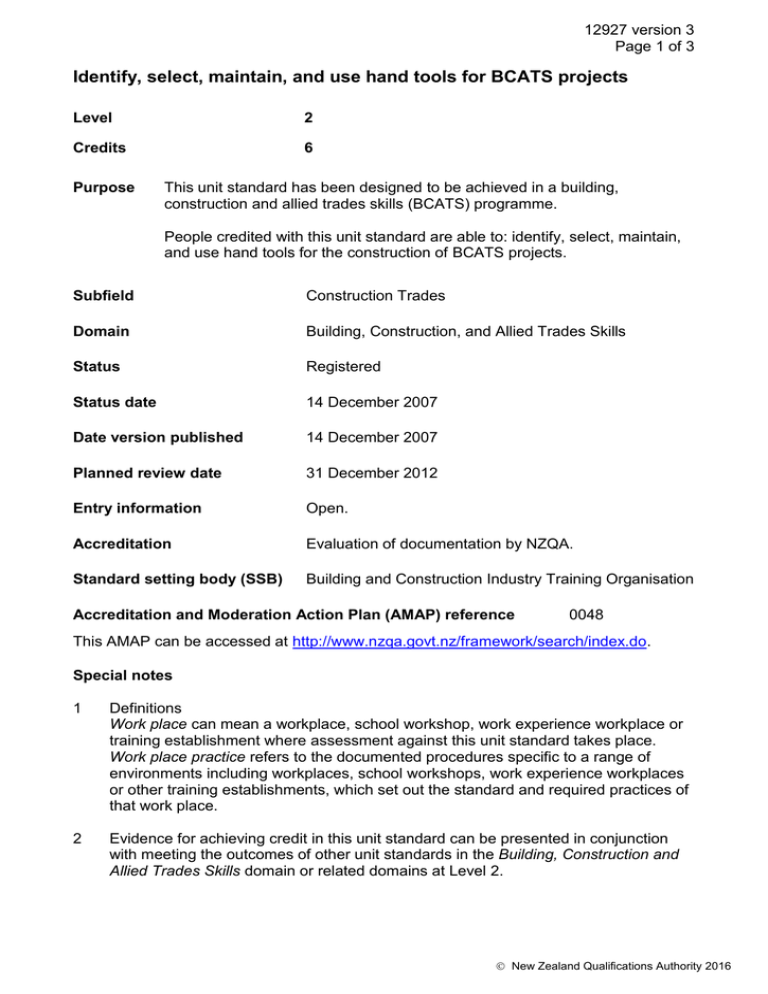
12927 version 3 Page 1 of 3 Identify, select, maintain, and use hand tools for BCATS projects Level 2 Credits 6 Purpose This unit standard has been designed to be achieved in a building, construction and allied trades skills (BCATS) programme. People credited with this unit standard are able to: identify, select, maintain, and use hand tools for the construction of BCATS projects. Subfield Construction Trades Domain Building, Construction, and Allied Trades Skills Status Registered Status date 14 December 2007 Date version published 14 December 2007 Planned review date 31 December 2012 Entry information Open. Accreditation Evaluation of documentation by NZQA. Standard setting body (SSB) Building and Construction Industry Training Organisation Accreditation and Moderation Action Plan (AMAP) reference 0048 This AMAP can be accessed at http://www.nzqa.govt.nz/framework/search/index.do. Special notes 1 Definitions Work place can mean a workplace, school workshop, work experience workplace or training establishment where assessment against this unit standard takes place. Work place practice refers to the documented procedures specific to a range of environments including workplaces, school workshops, work experience workplaces or other training establishments, which set out the standard and required practices of that work place. 2 Evidence for achieving credit in this unit standard can be presented in conjunction with meeting the outcomes of other unit standards in the Building, Construction and Allied Trades Skills domain or related domains at Level 2. New Zealand Qualifications Authority 2016 12927 version 3 Page 2 of 3 3 Assessment against this unit standard may occur in a wide range of environments, including workplaces, school workshops, work experience workplaces or other training establishments. 4 Legislation relevant to this unit standard includes: Health and Safety in Employment Act 1992; Health and Safety in Employment Regulations 1995. Elements and performance criteria Element 1 Identify, describe and select hand tools for BCATS projects. Range steel rule, folding rule, carpenter’s pencil, measuring tape, try square, combination square, sliding bevel, spirit level, string line, plumb bob, cross cut saw, coping saw, hacksaw, chisels, planes, oilstone, rasps and files, sanding block, claw hammer, nail punch, pinchers, hand drill, twist bits, screwdriver, adjustable spanner, pliers, cramps. Three specialist tools used in working with any of the following materials – metals, glass, concrete, plastics, upholstery (fabric or leather), manufactured boards. Performance criteria 1.1 The capabilities and limitations of construction hand tools are identified in terms of the manufacturers’ instructions for use. 1.2 Use of tools is described in terms of work operations to be completed. 1.3 Safe use of each tool is described. 1.4 Tools are selected to meet identified job requirements. Element 2 Use hand tools for the construction of BCATS projects. Range tools used for three BCATS projects. Performance criteria 2.1 Tools are used to complete work in accordance with job requirements. 2.2 Use of tools is in accordance with manufacturers’ instructions, materials and construction process requirements. 2.3 The use of tools complies with the specific industry and work place safety requirements. New Zealand Qualifications Authority 2016 12927 version 3 Page 3 of 3 Element 3 Maintain hand tools. Range tools used for three BCATS projects. Performance criteria 3.1 Any cutting edges are ground and/or sharpened in accordance with manufacturers’ instructions and work place practice. 3.2 Tools are kept free of rust and dirt, and are stored and maintained in accordance with manufacturers’ instructions and work place practice. 3.3 Damaged, blunt or faulty tools are reported to supervisor in accordance with work place practice. Please note Providers must be accredited by NZQA, or an inter-institutional body with delegated authority for quality assurance, before they can report credits from assessment against unit standards or deliver courses of study leading to that assessment. Industry Training Organisations must be accredited by NZQA before they can register credits from assessment against unit standards. Accredited providers and Industry Training Organisations assessing against unit standards must engage with the moderation system that applies to those standards. Accreditation requirements and an outline of the moderation system that applies to this standard are outlined in the Accreditation and Moderation Action Plan (AMAP). The AMAP also includes useful information about special requirements for organisations wishing to develop education and training programmes, such as minimum qualifications for tutors and assessors, and special resource requirements. Comments on this unit standard Please contact the Building and Construction Industry Training Organisation national.office@bcito.org.nz if you wish to suggest changes to the content of this unit standard. New Zealand Qualifications Authority 2016
